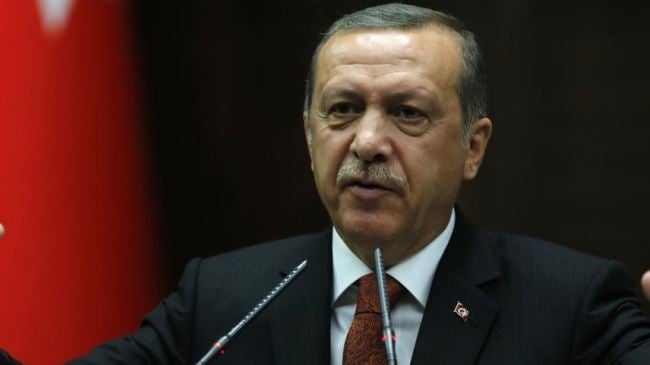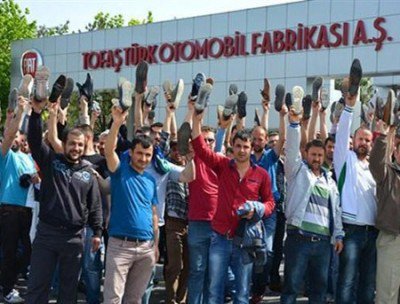By Sungur Savran
So at long last, despite all the meanders and sideways and detours of history, the logic of social struggles has finally put its stamp on the politics of Turkey. The resounding defeat of Recep Tayyip Erdogan and his AKP at the polls in the 7th June general elections in Turkey brings out into the open a loss of political clout on the part of Erdogan as a result of the successive blows he received in the last two years at the hands of the masses and, partly, his erstwhile partners.
Two years ago almost to the day, the masses descended on the streets all over Turkey to demand the resignation of the Erdogan government, who was then prime minister, protesting not only the project of the demolition of the Gezi Park in the very centre of Istanbul with the purpose of building a shopping mall, but even more importantly against the wholesale suppression of freedoms and sectarian war-mongering in Syria. [See Bullet No. 831, Bullet No. 834, Bullet No. 837.] The popular rebellion that ensued lasted from June to September, was ferociously suppressed by the police at the explicit urging of the prime minister himself, but left Erdogan scathed and breathless. As a result of the revolt and the brutal tactics he adopted to put it down, Erdogan came to be regarded by his former allies and partners as a liability rather than an asset in terms of guaranteeing economic and political stability for Turkish capitalism.
Serhildan, Kurdish Intifada
Only one year after the popular rebellion triggered by Gezi, in October 2014, it was the turn of the Kurds to rise up in what is called a serhildan in Kurdish, the counterpart of an intifada. The triggering factor this time was the events in Rojava, Syrian or Western Kurdistan, which had gained autonomy in 2012 from the Baath regime. Kobane, one of its three cantons, was attacked by the ISIL, the organization that declared the makeshift Islamic State in parts of Syria and Iraq under the self-appointed Caliph al Baghdadi. Due to his Sunni sectarian struggle against what he considers to be an Alevi regime, Erdogan has pursued a poisonous hostility against the Syrian regime, supporting all kinds of fundamentalist movements including the ISIL. As the ISIL was attacking Kobane, he made the immense mistake of throwing a challenge to the Kurds, saying “Kobane is on the verge of falling.” That very night millions were out on the streets of Turkey’s Kurdish cities. Quiet returned to the region only after a week and only at the behest of the Kurdish movement, including a quickly prepared address by Abdullah Ocalan, the PKK leader in prison.
Two popular rebellions within an interval of one year should be sufficient grounds to worry any political leader. However, history held more in store for Erdogan. The missing actor in all this was the working-class. Sections of this class were heavily represented in Gezi, but did not put forth class demands with methods peculiar to the proletariat. Gezi was thus an intra-class popular movement that did not bear a proletarian imprint. Between Gezi and the Kobane serhildan, in May 2014, there was the Soma tragedy, a massacre that goes under the name of “work-related accident” in a mining area in the Aegean region, in which 301 workers lost their lives. This brought the class question forcefully on the agenda. The callous manner in which Erdogan and his government handled the whole affair has added to popular anger. But more important is the ongoing struggle in the metallurgical industry. The government had banned a lawful strike of 15 thousand metalworkers in January this year, under the ludicrous pretext of ‘national security’. However, the metalworkers came back with a vengeance, staging this time a wildcat strike that brought tens of thousands of workers into struggle from mid-May on, right on the eve of the election. This movement was not against the government per se, but rather the yellow gangster union supported by all governments since the military regime of 1980 and against the metal employers’ organization. However, it certainly added to the atmosphere of malaise in the country and may well have influenced the results of the elections. More important will be its impact for the long term by raising the curve of the class struggle not only in the metal industry but across the board.

It is this concatenation of events that had already eroded the credibility and prestige of Erdogan that was behind the debacle he suffered in the 7th June elections. This is confirmed by the fact that it was the electoral victory of the HDP, the People’s Democracy Party, that sealed Erdogan’s fate. This is an avatar of the Kurdish legal movement that now encompasses a variety of Turkish socialist parties and groups. The Kurdish parties in this tradition had, over the years, been able to garner only around six per cent of the popular vote, which fell short of the incredibly high 10 per cent threshold required for a party to send representatives to parliament, a patently anti-democratic provision imposed by the military government of the early 1980s to keep socialist and Kurdish parties out of parliament. This time the new party received a full 13 per cent of the popular vote, close to 6 million votes in absolute figures, a landslide in its own right. This implied a loss of at least 50 seats for the AKP. Behind this lie two major factors.
One is the alienation of broad sections of the Kurdish population that used to vote AKP in the past, This alienation is a result of Erdogan’s callousness in the face of the plight of Kobane and his tergiversations regarding the so-called ‘solution process’, i.e. the negotiations with the PKK and Ocalan. The other factor is the unprecedented fact that many Turks of modern petty-bourgeois standing or from the upper strata of the proletariat, office workers and public employees for instance, voting for a Kurdish party. This section of the population traditionally has an obsession with Kemalism, secularism and the republic and is, therefore, hostile not only to Islamism but also the Kurdish movement, which it considers is against the interests of what it regards as the ‘indivisible unity’ of the country. It was these people who raised the vote of the HDP to a level of over 10 per cent in cities like Istanbul and Izmir. If major sections of these strata voted for a predominantly Kurdish party, it was because the participants of the Gezi revolt had experienced an epiphany, discovering at long last the cruel repression to which the Kurdish people had been subjected for decades. So it was, in very concrete terms, a result of the Gezi rebellion and the Kobane serhildan that led to the doubling of the votes of the HDP and the consequent defeat of Erdogan.
The Reprieve
Only one question remains to be answered: why is it that this defeat took so long to be registered in action, even letting Erdogan to climb to the presidency of the republic last August? The answer to that question lies in three different factors. One has to do with the politics of the ruling forces. As we have earlier stressed, the Gezi rebellion destroyed the prestige of Erdogan in ruling circles, nationally and internationally. The U.S. and the EU started to regard him as a factor of instability for a very precious NATO ally. The liberals, right and left, who had been the mainstay of Erdogan with respect to his support in the secular sections of society, moved away perforce, not being able to stomach his brutal methods in dealing with the protesting crowds. The Gulen fraternity, a powerful empire in the spheres of education, the media, the police and the judiciary and an informal coalition partner of the AKP for a whole decade, betrayed him, opening up dossiers of corruption in December 2013. Yet despite this Erdogan survived and was ultimately elected president. This was because his erstwhile enemies saved him from ruin.
The traditional ruling forces dreaded the prospect of an immediate fall of Erdogan leading either to a severe economic crisis or to a new uprising of the masses (or both indeed) and so joined forces to keep him in power. These forces were of two different backgrounds. First, elements of the top brass had been thrown into prison and were being tried for coup-mongering against the AKP government in two cases called the “Ergenekon” and the “Sledgehammer”. Pushed into the corner, the AKP government came to an agreement with these forces, who would refrain from working to bring him down in return for their release and total absolution. The deal was not closed, however, before the head of the most powerful capitalist group in Turkey, Koç Holding Company, partner of Ford, Fiat and many other multinationals in Turkey, stepped in to mediate between the two. Now, the Koç family themselves were on the other side of the divide within the Turkish bourgeoisie opened up by Erdogan: they are the strongest group of the Westernizing-secular wing of the bourgeoisie engaged in a power struggle with the newly rising Islamist wing, the latter being unambiguously favoured by Erdogan. It was this alliancecontre nature that gave a temporary respite to Erdogan after the earthquake of Gezi.
The second factor has to do with the fact that he has established a very personalistic and charismatic relation with a sizeable sector of the population, a sector that has generally been despised and disdained by the educated and the rich. This feat is not only of his own making. These masses felt that their lifestyle and religion had been repressed by the fiercely secular republic and added a cultural aversion to a class instinct of hostility to the traditionally ruling Westernized upper crust of society, both the bourgeoisie proper and its agents in politics. Erdogan, coming from a more humble background, seemed to them to be one of their own.
The Left
The third factor was the errors of the left and the Kurdish movement. For their different reasons, these forces simply did not grasp the radical weakening of Erdogan as a result of the Gezi rebellion. The socialist left, having lost all faith in the masses as the prime mover of history, abandoned the path of the rebellion at an incredible early stage for a strategy that can only be characterized as parliamentary cretinism at its worst. As Erdogan was teetering on the edge of the precipice in December 2013 as a result of the incontrovertible evidence presented to the public with respect to the corruption in which not only his ministers but he himself had been involved up to the neck, the left was preparing grand strategies for the local elections at the end of March! Not only was the timing disastrous, but this was a classic case of confronting the enemy where the latter is the strongest, i.e. in the electoral arena, for reasons explained above. And this in a country which had only come out of a popular rebellion only three months ago.
As for the Kurdish movement, they shied away from joining the popular rebellion for fear that Erdogan being brought down, the ‘solution process’ would immediately come to a halt. However, they did not realise that becoming part of such a large popular rebellion, they would in fact, minimally, become a much more powerful actor who simply could not be ignored. Their fear that the Turkish nationalist wing of the Gezi rebellion would be able to bring the army back into power showed utter incomprehension of the power of the people.
The erroneous policy of the left provided a breathing space for Erdogan that gave him the possibility of climbing to the presidency. Now the AKP cannot form a government on its own, but Erdogan will still be holding the reins of power. He will use every inch of the space he has thus conquered to cling on to power and may even resort to war against the Kurds or in the Middle East at large for that purpose. In politics every mistake has a price.
Fortunately for us all, this is not the only reality that Turkey presents. To understand what kind of period Turkey is going through, just look at the facts: a people’s rebellion in the western half of the country in 2013, a people’s rebellion in the eastern half of the country in 2014, a massive wildcat strike movement of metalworkers, still continuing, in 2015. What more can history bring together to make possible a breakthrough that would carry the working masses and the oppressed to power? When that happens, we will look back and say, “Well burrowed, old mole!”
 Geostrategic Media Political Commentary, Analysis, Security, Defense
Geostrategic Media Political Commentary, Analysis, Security, Defense






You must be logged in to post a comment.